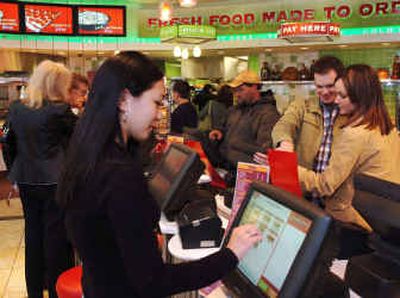More than a pit stop

Gas stations as gourmet destinations?
It’s an unlikely culinary revolution, but Slim Jims are making way for sushi as convenience stores transform themselves with upscale eats and shed their image as junk food pit stops.
It’s an attempt by the industry to discourage the gas-up-and-go mentality and bolster the bottom line with artisanal cheeses, freshly baked breads and high-end meals that entice consumers to linger and eat — and to do it often.
“We’re trying to make these stores destinations rather than convenience stops,” said Stuart Lowry, marketing director for The Markets of Tiger Fuel, a Virginia convenience chain that offers fresh seafood, a fancy deli and professional chefs.
“If you choose to just get in and get gas you can,” Lowry said. “But if you want to sit down and have a gourmet meal, you can do that, too.”
The change comes at a crucial time for the nation’s 138,000 convenience stores, most of which historically have relied on gasoline and cigarettes for more than three-quarters of their sales. At the same time as profit margins on those products are shrinking, the $395 billion industry is facing tough new competition from grocers adding fuel pumps and drug stores that offer more food than pharmaceuticals.
Until recently, the industry has focused mostly on one type of customer, what National Association of Convenience Stores spokesman Jeff Lenard calls the Bubba — a blue collar man who smokes.
Reaching beyond Bubba has meant a new generation of convenience stores — bigger, brighter and more upscale than their predecessors — that compete less with service stations and more with grocers and restaurants.
Bubba is being replaced by the grab-and-go affluent, people who spend considerable time in their vehicles and demand portable meals, but want more than Slurpees and shrink-wrapped sandwiches, Lenard said.
The economics of the transformation make sense. A good price on fuel might get people in the door once or twice a week. Great coffee, brick-oven pizza and gelato could pull them in daily.
“Most retailers will tell you they can make more money off a 12-ounce cup of coffee than a 12-gallon fill-up,” Lenard said.
That’s the plan at Exxon Mobil Corp.’s 659 On the Run convenience stores, where the company recently spent $10 million developing a proprietary line of gourmet coffee called Bengal Traders.
Since many customers are more loyal to good coffee than to gasoline brands, that’s money well spent, said Russ Ritenour, the company’s hot beverages manager. Exxon Mobil even has added a new position at its stores — brew master.
Most companies are taking a broader approach, outfitting their shops with kitchens or forming partnerships with existing restaurants, such as Subway and Dunkin’ Donuts. Many shops will even bring their food to you with catering services.
Today, 80 percent of convenience stores offer food prepared onsite, making it one of the fastest growing segments of the food service industry, according to the National Restaurant Association.
All that food prep takes space, and newer shops have it. Today’s convenience stores average about 3,000 square feet, nearly 25 percent larger than those built just a decade ago, according to the convenience stores association.
Bill Knight upped that ante when he opened his 12,500-square-foot flagship NexStore MarketPlace in Boca Raton, Fla., last December. Nearly two-thirds of the space is kitchen. Outside there are nearly 300 parking spaces.
He needs the room. Knight employs 41 chefs who prepare 120 different baked items, including cakes, pies and pastries, 12 soups, 16 varieties of sushi and more than 150 different deli items. There’s also a meat carving station.
Oh yeah, and he sells gas, too. At 20 pumps.
Knight’s shop may sound excessive, but it’s no anomaly.
Sheetz, Inc., an Altoona, Pa., company with hundreds of convenience stores along the mid-Atlantic, recently opened two 10,000-square-foot shops that offer dining rooms, espresso bars and salads and pizzas made-to-order.
“The whole convenience dynamic is changing and changing in a big way,” said Bill Reilly, vice president of sales and marketing for Sheetz, which plans to open dozens more super-shops this year.
The changes aren’t without challenges. Fancy foods won’t play in every neighborhood.
“Having them see 7-Eleven as a good alternative to a McDonald’s or a Burger King is a challenge,” conceded Jim Keyes, president of 7-Eleven.